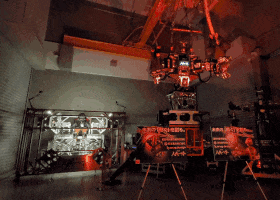Japanese company Man-Machine Synergy Effects has shown a prototype of a large humanoid robot with arms and head, controlled by a VR stand. The operator inside the stand moves his hands, and the stand converts these movements into similar movements of the robot.
Almost all humanoid robots are either commensurate with it, or smaller in size (although there are exceptions in the form of BCR). First of all, this is due to the fact that robots somehow work next to a person and in an environment adapted for people. But in some cases, a robot larger than a human can be useful, for example, in the production of large structures or in a disaster zone with large blockages. Nevertheless, it is difficult to create such robots, because there are almost no developments for them either in research works or in serial devices, and it is not always easy to scale designs and technical solutions.
The Japanese company Man-Machine Synergy Effects (obviously, it is named by analogy with [...] the concept of robots of the same name presented in 2008, controlled by human movements, but controlling their strength so as not to cause injury to them) has presented a prototype of a large humanoid robot. It reproduces the upper part of the human body — the torso, two arms, and the head. The company does not name the exact size of the robot, but judging by the videos, it is 2-3 times higher than a person, and in addition, it is located on a high platform.
On each hand, the robot has three fingers with which it can grab objects. At the demonstration, the robot grabbed only a light polymer stick and a soccer ball, but it is probably able to lift large loads. The robot's hands are controlled by a human in a VR stand.
It has a chair with two large hand levers and two pedals. During the demonstrations, the pedals were fixed in place, but it seems that in the future they will work as levers for the hands and allow the robot to move its legs. All the levers are attached to the stand via a delta robot -a three-arm structure, the end of which can move in any direction. The operator can move the arm levers in the desired direction and thus move the robot's arms.
The operator sits in a stand with a VR helmet on, broadcasting to him stereoscopic images from two cameras on the robot's head. It also reads the movements of the head and transfers them to the robot's head in real time.
This robot does not use direct copying of human movements, but controls using levers, the position of which is transferred to the robot. This scheme has previously been used on smaller robots, but in addition to it, there is also another approach, in which the reader is attached to the human limbs and completely copies their position, working on the principle of an exoskeleton.
Grigory Kopiev

